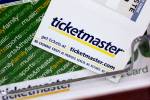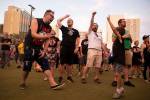Henderson Symphony Orchestra celebrates 25 years
Conductor Taras Krysa speaks of "the spirit of the music."
Concert Master Garth McBride says it comes down to "we want to play."
Members of the Henderson Symphony Orchestra share a lot, including a love for classical music, a deep respect for their conductor, and that need to perform before live audiences.
This year they have something extra to be proud of: the community orchestra's 25th anniversary.
And they're celebrating it with a series of concerts to fit every classical music lover's tastes, including some guest soloists.
SMALL BEGINNINGS
Today, the Henderson Symphony Orchestra boasts more than 90 members, though the concert roster consists of 65 musicians who are masters at playing the wind, brass, string and percussion instruments every orchestra must have.
Not bad for an orchestra that started with two violinists, one drummer and one flutist who founded the group way back when Henderson was still a small town known more for its heavy industry than its affluent subdivisions and 100 parks.
Frank Irvin, the orchestra teacher at Basic High School, founded the Henderson Symphony Orchestra in 1986 with an ambition no bigger than giving his students a place to practice and perform once their high school careers closed out.
The Mozart they played had an unusual snare drum beat rather than the kettle drum. The acoustics left a lot to be desired. They shared a practice hall with the Department of Motor Vehicles, and their first outdoor concert was ruined by an all-too-common Nevada windstorm.
But the orchestra persevered and eventually grew.
As it improved, city officials realized it could add to Henderson's image and it began to enjoy financial support from Henderson's Cultural Arts and Tourism Department.
BRINGING IT ON
Orchestra members bring high culture to a region that is often derided as having no culture at all.
For the most part they play for free and consider doing so a privilege.
They range in age from the early 20s to, until recently, 90.
They come from all walks of life and share one love: classical music.
Organizing practice time can be a bit like herding cats since most musicians have regular jobs, but playing the cello, the violin, the tuba or trombone is not like riding a bicycle: You can't stay away for years or even weeks and expect to pick up where you left off.
"I think it's a wonderful organization," said Concert Master McBride. "Most of us musicians are amateurs and this is a great place for us to play and that's the thing -- we want to play. We're not just doing this to make a living. We're doing this for free because we know we're blessed to be around so many wonderful musicians."
For cellist and young mother Bethany Swain, the dedication required of musicians who perform for free is significant.
"As a volunteer musician the demands on my time are intense," said Swain, who started playing the cello again one month before she gave birth to her youngest.
It's not just the musicians who make the magic happen. Families help, too.
"There has to be lots of buy-in from your significant other," Swain said. "I need him to watch the kids quite a bit or else I couldn't do this."
THE CONDUCTOR
Swain has high praise for Krysa, who she says changed how the orchestra prepares for a concert. In previous years, they would practice once a week for six weeks before their next concert, but this year they began rehearsals just a few weeks ahead of a concert, with several practices planned for each week. That helps them focus on their music.
For Swain, 39, the hour or two of daily practice time is worth it thanks to Krysa, whom she credits with "raising the bar" for every musician. A member of the orchestra since 2005, Swain believes Krysa has transformed the symphony.
"Taras has been incredibly influential," Swain said. "Just the way he thinks, it's a wonderful thing."
"We're only limited by our abilities," said Molly Murphy, executive director of the symphony, who plays the oboe. "The skill level of the orchestra has increased under Taras, both in soul and structure."
Krysa, for his part, says he tries to "surprise people."
"We know better than to underestimate the audience's sophistication, and we try to give them something they haven't heard before," said the conductor, who also is an assistant professor and director of orchestras at the University of Nevada, Las Vegas.
"This is complex music, and very radical music both for the audience and the orchestra," Karas said.
"Artistically, we want to introduce the community to the orchestra as if it were a museum," Krysa said. "This gives the listener a different vibe; we can take the audience to different eras. It's an opportunity to program works considered to be on the edge."
musical celebration
Krysa hopes to display some "surprise" at his 25th anniversary season, with more concerts, special music and guest soloists.
The orchestra will play Ludwig van Beethoven's Symphony No. 8 at its Sept. 17 season opener. "It's a little quirky," said Krysa, who came to the United States from the Ukraine in 1989.
Audiences enjoy Beethoven's 8th because it is light-hearted though complex, Krysa said.
Guest soloists will include DeAnne Letourneau, who will play violin at the Sept. 17 Beethoven concert, and Mykola Suk, a pianist who will solo in a performance of J. Sibelius Symphony No. 1 in October.
The orchestra will also perform for Veterans Day in November and will put on its annual holiday program in December.
The most entertaining might be the last concert of the season when the orchestra will play in a pit while the Charlie Chaplin classic "Modern Times" is projected on a screen, just like when it was filmed in 1936.
While concerts are free, donations of $10 are appreciated.
Contact reporter Doug McMurdo at dmcmurdo@reviewjournal.com or 702-224-5512.
Henderson Symphony Orchestra
2011-12 concert schedule
(Pre-concert discussions begin one hour prior to the posted start time.)
Sept. 17, 8 p.m.
Henderson Pavilion
Beethoven Prometheus Overture
Beethoven Symphony No. 8
Oct. 28, 8 p.m.
Henderson Pavilion
Anniversary concert
J. Sibelius Symphony No. 1
Nov. 5, 10 a.m.
Henderson Events Plaza
Veterans Day Program
Dec. 9, 8 p.m.
Henderson Convention Center
Holiday program, light classics
Feb. 10, 8 p.m.
Henderson Convention Center
Debussy's Ravel
March 11, 8 p.m.
Henderson Pavilion
Young people's concert
May 4, 8 p.m.
Henderson Pavilion
Martinu Lidice
June 1, 8 p.m.
Henderson Pavilion
Charlie Chaplin - "Modern Times"





























